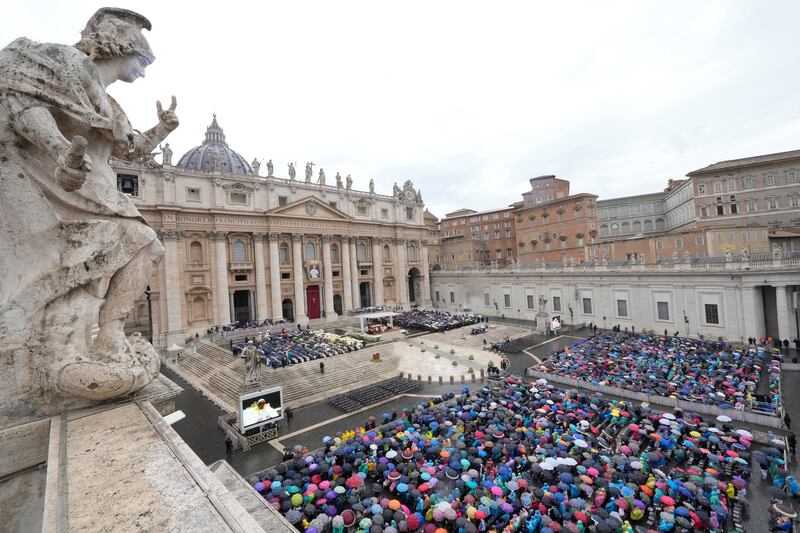Pope John Paul I, whose 33 days as pope in 1978 was one of the shortest in Catholic Church history, was beatified by Pope Francis at St Peter’s Square in Rome on Sunday.
Cardinal Albino Luciani (65) was elected pope on August 26th, 1978 following the death of Pope Paul VI. He took the names of his two immediate predecessors, Pope John XXIII and Pope Paul, as Pope John Paul I. He was the last Italian pontiff of recent times and died on September 28th, 1978, to be succeeded by Pope John Paul II.
Known as “the smiling pope” because of his happy demeanour, Pope John Paul I is remembered today mainly for the many conspiracy theories surrounding his unexpected death and which were sparked by the Vatican itself which first claimed his remains had been discovered by his Irish secretary, Msgr John Magee, who subsequently became Bishop of Cloyne in 1987.
The only man to be secretary to three Popes — Paul VI, John Paul I and John Paul II — Bishop Magee resigned in 2010 over his handling of clerical child sexual abuse allegations in Cloyne, an area which takes in much of Co Cork.
The 100 best Irish books of the 21st century: No 100 to No 51
Gerry Thornley: Jack Crowley’s patience rewarded as Ireland go in search of Rome revival against Italy
An Irish Diary on memorable gigs from John Denver in the RDS to Bruce Springsteen in Slane
Catherine Fulvio’s St Patrick’s Way review: Glorified advertorial is a blizzard of bland. It’s a disservice to the celebrity chef
The Vatican was initially uneasy about acknowledging that women had discovered Pope John Paul I’s remains in the papal apartments and announced that it was Msgr Magee who did so. This was corrected later to say the deceased pontiff was found by two nuns bringing in his morning coffee. Sr Margherita Marin of the Congregation of the Sisters of the Child Mary was an assistant at the papal apartment when she and Sr Vincenza Taffarel found his body.
As recently as last Friday, at a press conference in the Vatican, one of the chief promoters of the canonisation of Pope John Paul I raised the issue of conspiracy theories surrounding his death. Stefania Falasca said that thanks to scientific research it was possible to challenge “the fake news about death by poisoning that persisted for a long time”.
She called this conspiracy theory “a lie which has engulfed for so many years the consistency and magisterial calibre of this man and this pope. It is incredible that 44 years after his death we are still wondering why he was murdered,” she said.

Referring to medical records, court depositions and doctors’ reports, she said these had led professionals to conclude that Pope John Paul I’s demise was “sudden death. It was a heart attack,” she said. He had warnings of a heart attack the night before he died through a hint of chest pain which he mistook for rib-cage pain, she said, and he went to bed greeting the nuns as he did every night and telling Sr Margaret, “tomorrow we will see each other, if the Lord still wishes it, and we will celebrate Mass together”, she recalled.
This was confirmed at Friday’s press conference by the now elderly Sr Margaret.
In his 1984 book In God’s Name, British author David Yallop suggested Pope John Paul I had been murdered because he was about to expose corruption involving the Vatican Bank and the Mafia. This was challenged in 1989 by British historian John Cornwell in his book A Thief in the Night, which concluded Pope John Paul I died of a pulmonary embolism.
Discovery of Freemasons
Others linked the pope’s death to his alleged discovery of Freemasons among senior figures at the Vatican, to the CIA, and to those opposed to plans they allege he had to restore the Latin Mass, among other conspiracy theories.
In order for anyone to be beatified, or declared Blessed, in the Catholic Church a proven miracle must be attributed to the candidate. In the case of Blessed Pope John Paul I the 2011 cure of a young girl in Buenos Aires, Argentina, has been attributed to him. Roxana Sosa had been suffering from malignant refractory epilepsy when Fr Juan José Dabusti suggested the child’s desperate mother pray to him. The woman had called the priest after doctors told her Roxana would not live through the night.
Speaking at that Vatican press conference last Friday, Fr Dabusti recalled how “looking at her [the mother] in that condition, I was inspired to turn to John Paul I to ask for the healing of her child, and together with her and some nurses present, I prayed to him. Until that moment I had never prayed to John Paul I for a healing. Why did I propose to Roxana to pray there for Luciani to intercede? I don’t know. It was the Holy Spirit.”
The child was cured. In 2019 the Vatican certified that there was no scientific explanation for her recovery. Another miracle will be required before Blessed Pope John Paul I can be declared a saint.
Speaking at the beatification ceremony on Sunday Pope Francis recalled how “with a smile, Pope John Paul managed to communicate the goodness of the Lord. How beautiful is a church with a happy, serene and smiling face, that never closes doors, never hardens hearts, never complains or harbours resentment, does not grow angry or impatient, does not look dour or suffer nostalgia for the past.”















